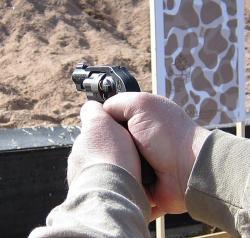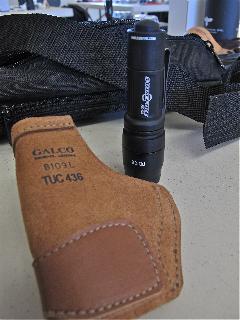Widgetized Section
Go to Admin » Appearance » Widgets » and move Gabfire Widget: Social into that MastheadOverlay zone
Mice and Lights
Hitting a target with a small gun is tough. Unless you’re planning on using your “belly gun” on someone’s belly, chances are you’re probably laboring under the misconception that you’re working with a truly last-ditch weapon when you’re carrying one of today’s variety of smaller pistols and revolvers.
Granted, you’re giving up a lot of energy and impact when you move your calibers downward from, say, .45ACP.
Today, however, that downsizing absolutely does not mean you’re defenseless.
It does means you’d better recognize the fact you are not equipped to become a force for justice by charging into a holdup or trying to break up a gang fight.
You are equipped to turn away someone who’s intention is to do you or your companions harm.
You are decidedly not equipped with super weapons that are going to stop criminals in their respective tracks.
“These are not offensive weapons,” says Gunsite Academy Rangemaster Giles Stock speaking of the small concealed carry guns we’ve been practicing with at Gunsite, “these are the weapons you have when everything else has failed or you’re unable to have a full-sized firearm. What you should learn should include not sticking around to get into a gunfight.”

The small revolvers and semiauto pistols were capable of stacking rounds on top of each other, but their effectiveness was significantly reduced under high-stress situations.
During our day and night training sessions with SureFire lights and Ruger LCRs, LCPs and Smith & Wesson snubbies, the best instruction on how to prevail in gunfights came from Stock: “Here’s the first rule in gun fighting: Don’t do it. If you have a choice, run away. Don’t stick around and attempt to earn someone’s respect by standing up to them.”
That’s a sentiment echoed by fellow trainer and former Los Angeles police officer Bill Murphy, “If you have an appointment for a gunfight, don’t show up. If you have to go to a gunfight, take along all of your friends who own guns, too.”

When you're packing a pistol that's hardly larger than your pocket flashlight, remember you're not equipped to go looking for a gunfight. Fill the small Galco holster with your pocket pistol and carry the SureFire flashlight and you'll be far ahead of the unprepared.
At the same time, however, Stock and Murphy worked diligently to teach the media members in attendance that simply being able to shoot from a bench or shooting rest did not make you capable of defending yourself. To do that, they used a variety of scenarios, each created to get your pulse pounding, and your eyes glancing furtively in all directions. All the actions you work to get rid of in hunting or precision shooting.
Instead, their shooting instruction blended motion, unfamiliar surroundings and darkness to help raise our awareness of just how un-aware we generally are of our surroundings. In the dark, the majority of us are not only unaware, we’re unequipped for an emergency.
To help with the darkness, SureFire provided students with their small (4-inches long, 2.8 ounces with the 123A Battery), but bright (80 lumens) E1B Backup flashlights. These are dual-output (low/high) pocket lights developed for plainclothes officers or off-duty carry. It’s small, but the 80-lumen high beam is four times the brightness of the old 2-D-cell flashlight.
“It’s bright enough to overcome an attacker’s night vision,” said Stock, “and the ability to take away an attacker’s vision may give you the advantage you need to get away – or end the fight.”
Later, that led to a pretty powerful demonstration. On the shooting line in the dark, Murphy shined a flashlight into our eyes. Then we were asked if we could see the silhouette targets just five yards away. I certainly couldn’t. The second time around, we were told to turn our flashlights on toward the target and put two rounds center-mass. Surprisingly, the 80-lumen Backup gave plenty of light to make hits, even after being flash blinded by Murphy’s far bigger (and brighter) light.
Controlling- or at least minimizing- the impact darkness can have on you in an emergency situation adds a measure of sanity. Having the ability to see when your attacker might be disoriented and temporarily blinded can mean the difference in life and death.
With that understanding, and the demonstration of the ability of today’s small pocket guns to impact lethal damage to an attacker, we found ourselves feeling pretty good about our abilities when carrying these “mouse guns and penlights”.
When we put small rounds – like the Hornady 110 grain +P .38 Caliber Critical Defense loads into the ballistic gelatin test medium, we saw the damage could be significant, but not necessarily ballistically capable of one-shot stops.
On Friday, we’ll talk about how Stock and Murphy demonstrated to us- very effectively- why we shouldn’t over-rate the effectiveness of our small concealed carry weaponry. Especially when we couldn’t repeatedly put the rounds into the most damaging parts of our targets.
Here’s a hint: don’t try to fight a robot.
–Jim Shepherd



 MidwayUSA
MidwayUSA Ruger Firearms
Ruger Firearms SCCY Firearms
SCCY Firearms Streamlight
Streamlight Action Targets
Action Targets Gunsite Academy
Gunsite Academy
You must be logged in to post a comment Login